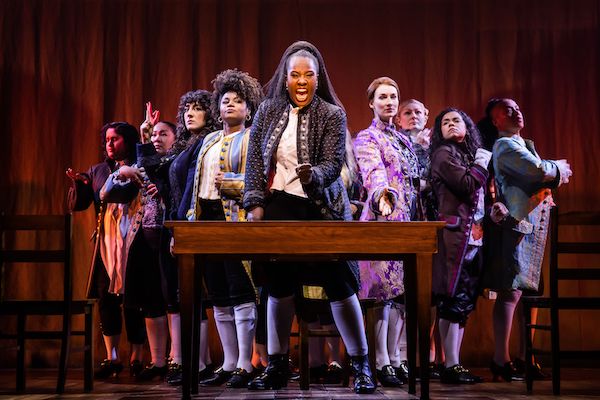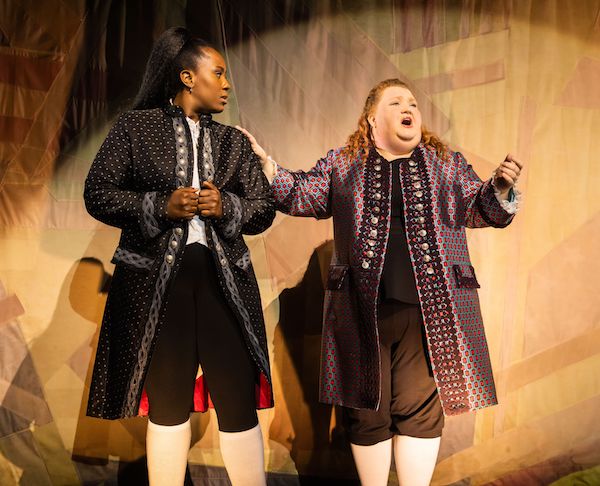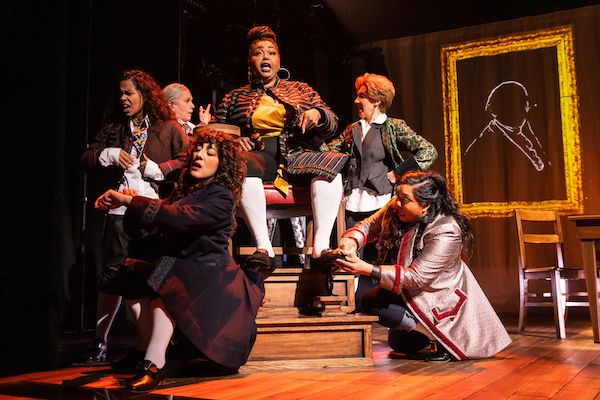Theater Review: “1776” — Still an Egg in the Theatrical Incubator
By David Greenham
This revival of 1776 tries to strike a culture wars balance, celebrating the country’s commitment to independence while also here and there skewering the idealized images and blatant hypocrisies of America’s patriarchal founders.
1776, Music and lyrics by Sherman Edwards, book by Peter Stone, based on a concept by Sherman Edwards. Directed by Jeffrey L. Page and Diane Paulus. Choreography by Page. Music direction by Ryan Cantwell. Scenic design by Scott Pask. Costume design by Emilio Sosa. Lighting design by Jen Schriever. Sound design by Jonathan Deans. Projection design by David Bengali. Hair and wig design by Mia Neal. Presented by American Repertory Theater and Roundabout Repertory Theatre Company at the Loeb Drama Center, Cambridge, through July 24.

Sushma Saha, Sara Porkalob, Mehry Eslaminia, Gisela Adisa, Crystal Lucas-Perry, Elizabeth A. Davis, Becca Ayers, Brooke Simpson, and Oneika Phillips in 1776, at the American Repertory Theater. Photo:: Evan Zimmerman for Murphy Made
A remarkable photograph was taken in the rotunda of the US Capitol building on January 6, 2021, that displays the “stop the steal” insurgents streaming in front of the famous John Trumbull painting Declaration of Independence. The picture depicts the moment of the signing of the celebrated document that proclaimed the country’s decision to rebel against England. The juxtaposition in the photo is stunning and depressing, given that those fighting for a Trump coup insisted that, given that the original revolution had floundered, it was time for a new one.
After much self-ballyhooing, this much anticipated revival of the musical 1776 has arrived, and the trend-makers (and Hamilton whisperers) at the American Repertory Theater and Roundabout Repertory Theatre Company also draw on the signing of the Declaration of Independence as a way to reenvision history. In this version, the roles of the members of the first Continental Congress — white men all — are performed by a multiracial, multigenerational cast that includes only female, nonbinary, and transgender performers.
Like so many 20th-century plays and musicals, 1776, which opened on Broadway in 1969, desperately calls for an update. In the over half a century since the show won three Tony Awards, including Best Musical, many of the air-brushed myths about our founding fathers have been undermined. Among the complicating facts: of the 47 original signers of our first guiding document, 34 were slaveholders. Perhaps no one in that First Congress has been the subject of a more radical change of heart than the author of the Declaration himself, Thomas Jefferson. Jefferson (played with grit and underlying anger by Elizabeth A. Davis) is one of the show’s three leading characters. His sexual involvement with his slave Sally Hemings after his wife’s death resulted in six children. The other two leads are John Adams (Crystal Lucas-Perry, who is solid in the role, but not nearly obnoxious or disliked enough) and Benjamin Franklin (the wonderful, but too understated, Patrena Murray). The action of the narrative spans two months during a blistering hot Philadelphia summer in May and June of 1776, culminating with the signing of the Declaration on July 4.
Like the insurgents in the attempted coup a year and a half ago, 1776, including this current revival, wraps itself in the American flag. In their concept for the production, directors Page and Paulus attempt to strike a culture wars balance, celebrating the country’s commitment to independence while also here and there skewering the idealized images and blatant hypocrisies of America’s patriarchal founders. This is a tricky juggling act, and at times the production manages to pull it off.

Crystal Lucas-Perry and Shawna Hamic in 1776 at the American Repertory Theater. Photo: Evan Zimmerman for Murphy Made
The opening moments are visually powerful as the show’s diverse cast members take the stage in street clothes and transform themselves into an ensemble of 18th-century leaders — many of whose names we may have last heard in our American history classes in school. Authors Edwards and Stone do a particularly effective job of establishing the “sides” that will play a key role in the ensuing tug-of-war of debates and stratagems. We know the ending, so the success of 1776 rests on how strongly the personalities (and their clashes) draw us in throughout the journey. It’s fun to watch the Congress members berate the irritating Adams, who wants to have a vote rather than open the windows in “Sit Down, John.” Half a century since the play’s debut, we can still relate when Adams proclaims, “I have come to the conclusion that one useless man is called a disgrace, that two or more are called a law firm, and that three or more become a Congress.” There are now a number of women in the US Congress but, sadly, the sentiment still holds. Other examples of pointed amusement can be found in the self-pride on display in Shawna Hamic’s blustery rendition of Richard Henry Lee’s “The Lees of Old Virginia.” And it’s fun to watch the authorship of the Declaration rumble and tumble into place as Adams and Jefferson battle, buoyed by comic relief from Franklin, Roger Sherman (surprise ensemble standout Brooke Simpson), and Robert Livingston (Gisela Adisa, who proffers a wonderful singing voice) in “But, Mr. Adams.”
The musical’s first act is about seeing the Founding Fathers as complicated people, and the compelling roots of this revival can be seen here, though more nuance needs to be liberally applied. The quiet moments in the staging are the most winning, especially those between John and Abigail Adams (Allyson Kaye Daniel). The text of their scenes and songs together is based on the many letters they wrote to each other. Lucas-Perry and Daniel enhance each other’s energy beautifully, even if the directors can’t quite determine whether or not the couple can really see each other or are just imagining they are together. The one addition to the show’s book is snippets from Abigail’s famous “Code of Laws” missive, which urges her husband to “remember the ladies” as Congress makes laws to govern the new country. (Interestingly, John’s response is not included. He wrote: “As to your extraordinary Code of Laws, I cannot but laugh,” adding that women are just “another tribe more numerous and powerful than all the rest.”)

(Clockwise from lower left) Mehry Eslaminia, Brooke Simpson, Allison Briner Dardenne, Liz Mikel, Joanna Glushak, and Lulu Picart in 1776 at the American Repertory Theater. Photo: Evan Zimmerman for Murphy Made
Where the production’s revision stumbles the worst is in dealing with Jefferson. Despite Elizabeth A. Davis’s intensity and eye-popping violin playing, the character is given a rough edge that the text doesn’t justify or support. he unsympathetic portrait might be related to the appearance of Jefferson’s enslaved aide Robert Hemings (Imani Pearl Williams), but it’s unclear. When, thanks to Adams’s maneuvering, Eryn LeCroy as Martha Jefferson arrives, the scenes takes on a weird edge, a sense of discord that continues through Martha’s homage to sexual satisfaction, “He Plays the Violin.” Instead of being a delightful song about connubial bliss that ends the first act, the manic energy of the performance leaves a sour taste that undercuts what’s to come in the next act.
Perhaps because of the discomfort generated by Jefferson, the shorter second act sets aside the founders’ quest for independence to focus on what are arguably the two most enthralling numbers in the show. In the canon of musical theater, few songs pack the political punch of “Molasses to Rum.” Focusing on the dominance of slavery, power, and money, the song anticipated Critical Race Theory 50 years before it had a name. The version here, led powerfully by Sara Porkalob as Edward Rutledge, draws on a pounding drumbeat to suggest the enduring presence of America’s original sin. As effective as that is, the show-stealing moment is supplied by Salome Smith’s passionate rendition of “Momma, Look Sharp.” The song is the final thoughts of a dying young man as his mother searches for his body after the Battles of Lexington and Concord. The tune has been reorchestrated and Smith’s emotionally powerhouse performance has been masterfully directed.
The problem is that these second-act highlights blow away the rest of the show. It reminds me of Franklin’s line as they’re considering the removal of the paragraph in the Declaration that is opposed to slavery. He tells Adams: “The issue here is independence! Maybe you have lost sight of that fact, but I have not.” Somewhere along the way the creative team driving this revival has lost sight of the story they’re supposed to be telling. The production comes off as increasingly choppy. The original Stone/Edwards material is far from perfect. But the narrative’s objectives were crystal clear. Page and Paulus are not sure how much spin they want to put on the material. Too critical for Broadway? Not critical enough? The result is that the musical’s elemental through line is lost.
Keep in mind that, in our current political climate, compromise has become a sin, and that is, in part, why it is worth revisiting the signing of the Declaration of Independence at this time. Whatever their faults, and despite considerable ideological differences, the Founding Fathers navigated their way to an indispensable compromise on the way to rebelling against Great Britain. The cast and the creative team have the talent and imagination necessary to tell that story in a moving and straightforward way — and to also suggest that we are aware of how far short our country has fallen regarding its initial promises and objectives. No need to bring out muskets to shoot ducks in a barrel.
As this production works its way through the sweltering hot summer in Boston and winds its way to New York in September, it will need to tidy up these messy ambiguities and ditch the intrusive political jabs. The dramatic stakes need to be raised so they can stand up to Act Two’s exceptional songs. To paraphrase the tune that Adams, Jefferson, and Franklin sing as the Declaration is read by the Congress, this 1776 is not yet an eagle, turkey, or a dove. It is an egg in the theatrical incubator. Let’s see what eventually hatches.
Editor’s Note: Commentary on 1776
David Greenham is an adjunct lecturer of Drama at the University of Maine at Augusta, and is the executive director of the Maine Arts Commission. He has been a theater artist and arts administrator in Maine for more than 30 years.
Tagged: 1776, American Repertory Theater, David Greenham, Diane Paulus

It’s refreshing to see a review from somebody who (unlike the reviewers in the larger media outlets) is actually familiar with the traditional productions of this show, and who can offer an informed viewpoint on the changes. I agree that, while there is a laudable attempt to take a new look at this material, much of the show needs work. Personally, I would start by eliminating the breaking of the fourth wall, which happens far too often and which seems like a crutch, like a comedian saying “Get it?” after telling a joke. I also wonder how the shallow staging can possibly translate to the larger American Airlines theatre in New York, where the show is destined. Losing elements like the final tableau to mimic the Trumbull painting is unnecessary; how much more powerful would it have been to have that scene re-enacted with the addition of the rum barrels in the background, instead of the cast turning its back to the audience to make us look. As the aphorism goes, “Show, don’t tell.” This production does far too much telling when it should be showing.
In my experience, Paulus is more entrepreneur than artist; she’s better at brand synergy than actually directing. Consider her extension of the Gershwin estate’s control over Porgy and Bess, for instance, or her clever idea to mashup the Montreal circus with Pippin (both of which sounded great on paper but yielded little in the way of new insights). Now 1776 offers a way to ride/extend the coattails of Hamilton. At first glance this sounds intriguing; ironically enough, Hamilton dodged the issue of slavery, while musty old 1776 grappled with it honestly. Clearly there’s an opportunity there. But I’m not surprised to hear Paulus doesn’t really meet that challenge; that’s just not what she does – the press concept is enough. But seriously, in today’s world does that really matter?